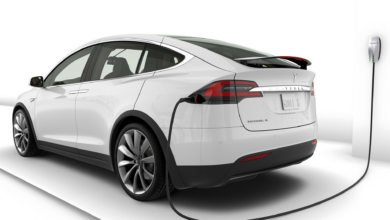
(CNN) – A university research project that turns into a startup, which within a few short years partners with Uber and attracts millions of dollars of investment from around the world, including Silicon Valley.
It’s the stuff of entrepreneurial dreams, and yet that’s what’s happened to Opibus, a Swedish-Kenyan electric mobility company.
Based in Nairobi, Opibus gives new life to old vehicles by converting them to run on electric motors. Beginning with 4x4s, the company’s reach has since expanded into public transport with bus conversions. Meanwhile, its electric motorbikes, designed and manufactured in Kenya, have attracted the attention of the world’s most famous ride-hailing app.
Opibus has roots as research by Linköping University students Filip Gardler, Mikael Gånge and Filip Lövström, whose project involved identifying places where electric mobility could have the largest possible impact. They pinpointed Kenya and established Opibus in 2017, starting their business by converting safari touring vehicles.
“We’ve always known the commercial potential (of electric conversion),” CEO Lövström says, adding it was easy to convince safari tour operators of the benefits of silent 4x4s that are driven on circular routes and return to the same recharging point.
Since then, Opibus has converted 4x4s for use in mining and other utility roles. The process is not cheap: prices start at just under $40,000 to convert a Toyota Land Cruiser and Land Rover, a 10-to-14-day process involving parts sourced from all over the world, says Lövström. But, he argues, the benefits outweigh the expense, and that much of the cost — along with the carbon footprint of the conversion — are recouped in the running of the electric vehicle (EV).
Why Kenya is primed for electric vehicles
Kenya, East Africa’s largest economy and a country where over 90% of domestically-produced electricity comes from renewable sources, presents a strong platform for clean electric mobility.
Fransua Vytautas Razvadauskas, mobility and cities senior consultant at market research company Euromonitor International, cites high prices as a barrier to entry, but so too infrastructure. “For the EV rollout to be successful (in Kenya), a large supply of charging units — both public and private — are needed to prevent range anxiety. This will, in turn, demand large investments in the upgrade of electricity distribution units, at homes and businesses,” he explains.
Using electric vehicles for public transport overcomes range anxiety and charging infrastructure issues to a degree. A bus operator knows how many miles it will travel in a day, what route and where it will stop, and charging units can be planned accordingly.
In January, Opibus began an electric bus pilot in Nairobi, installing off-grid solar power stations to charge its batteries (the company sells a range of off-grid solar modules and batteries — a clean energy source but also indicative of Kenya’s history of blackouts). The 51-passenger vehicle hasn’t been tested commercially yet, but the company plans to do so later this year.
Lövström believes that with a fast-growing population in sub-Saharan Africa and rapidly expanding cities, buses will be a vital part of the region’s infrastructure. “We really think that electric buses are a huge part of how to create this transition to electric vehicles, and how to reduce emissions on both a city and global level,” he says.
Opibus plans to manufacture the bus for a Pan-African market in 2023. It also has competition. Another Kenya-based startup, BasiGo, has announced it plans to start its own electric bus pilot program in March.
A revolution on two wheels?
Razvadauskas identifies the “largest opportunity” for EVs in East Africa as two- and three-wheeled vehicles, because they are cheaper and more popular than cars.
“In 2021, Kenya was home to 1.8 million motorcycles and mopeds compared with 1.2 million passenger cars — a tendency that is analogous in other regional countries such as Tanzania, Rwanda and Uganda,” Razvadauskas says.
Opibus is looking to corner the market through its Kenya-made electric motorbike.
The company decided to design its model from scratch because no existing motorcycles matched local users’ needs, says Lövström. “We need something that is very strong, very versatile, very robust, easy to repair and cheap at the same time,” he explains.
“Almost 90% of the motorcycles are built and designed locally,” says Lucy Mugala, a research and development engineer who helped create the motorbike. “(Electric vehicle manufacturing) is quite new in this county, so we are sort of pioneers.”
She says the motorcycle has evolved from having a single onboard battery to two removable batteries, which use a portable charger that can plug into any socket. In the near future, Mugala says docking stations packed with charged batteries could be a feature in cities, like today’s petrol stations.
Prices start at $1,400 for the motorcycle, which has a range of up to 200 kilometers (124 miles) and a top speed of 90 kilometers per hour (56 miles per hour). It enters a competitive market dominated by petrol motorcycles from Indian and Chinese manufacturers including Bajaj Auto and Haojun. Lövström concedes that Opibus’ electric motorcycle is currently “a few hundred dollars more” than conventional motorcycles.
In December, Opibus announced a strategic partnership with Uber as part of the ride-hailing company’s aim to be fully electric by 2040. Opibus will supply 3,000 motorcycles this year and is working with a financing partner for Uber drivers to own the electric motorcycles for commercial use
The company has sold 150 units to date and plans to produce 12,000 motorcycles in 2023. Outside Kenya, Opibus has motorcycle trials with different partners in Ghana, Nigeria, Sierra Leone, the Democratic Republic of Congo and Uganda.
“Expanding to other markets is definitely going to be a plus for us,” Mugala says, “but more so (is) bringing the cost of our electric motorbikes down as low as possible.”
Plans for expansion
Opibus received significant backing in the form of a $7.5 million round of investment in November 2021.
“This has really accelerated our mission to scale up production,” Mugala says, with the company intending to expand its 100-strong staff and its manufacturing space to meet its growing output.
Opibus has ambitions to establish regional hubs, but Kenya will continue as its base of operation — a country where senior staff from Sweden have been living for around five years already.
“We always knew that there were massive opportunities,” says Lövström. “That is very hard to understand when you’re not there. You need to be on the ground.”
“(Globally, there are) 150 to 200 million new vehicle sales per year, but we have 1.2 billion vehicles in the world already,” he says of the opportunity electric retrofitting represents. “We need to do something if we are to reach our targets of having green electric fleets across the world.”




